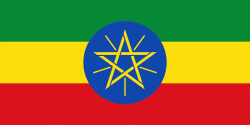Sebeta
Sabata (Oromo: Sabbataa) is a town in the Oromia Special Zone Surrounding Addis Ababa of the Oromia Region in Ethiopia.
The Sabataa School for the Blind is located in Sabata. It became part of the Haile Selassie I Foundation in 1959, and construction on a new building began on 4 October 1962. The Ethiopian Institute of Agricultural Research opened a research station in Sabata in 1967, which operates as the national center for research into improving fishing yields.
A plot to kill the Emperor near Sabata with a land mine in the road was discovered on 16 November 1969. Eight people were arrested, and the leader, 76-year-old Tekle Wolde Hawariat, killed himself next day after a gun battle with police at his home in Addis Ababa. He was mentioned without dishonor in the Ethiopian media because of his valuable service to the country in previous years.
A congregation of the Mekane Yesus Church was established in 1979. The congregation's church was burnt by a mob in April 1994, and the leaders of the Ethiopian Orthodox Church afterwards failed to condemn the act.
The Sabataa School for the Blind is located in Sabata. It became part of the Haile Selassie I Foundation in 1959, and construction on a new building began on 4 October 1962. The Ethiopian Institute of Agricultural Research opened a research station in Sabata in 1967, which operates as the national center for research into improving fishing yields.
A plot to kill the Emperor near Sabata with a land mine in the road was discovered on 16 November 1969. Eight people were arrested, and the leader, 76-year-old Tekle Wolde Hawariat, killed himself next day after a gun battle with police at his home in Addis Ababa. He was mentioned without dishonor in the Ethiopian media because of his valuable service to the country in previous years.
A congregation of the Mekane Yesus Church was established in 1979. The congregation's church was burnt by a mob in April 1994, and the leaders of the Ethiopian Orthodox Church afterwards failed to condemn the act.
Map - Sebeta
Map
Country - Ethiopia
 |
 |
| Flag of Ethiopia | |
Anatomically modern humans emerged from modern-day Ethiopia and set out to the Near East and elsewhere in the Middle Paleolithic period. Southwestern Ethiopia has been proposed as a possible homeland of the Afroasiatic language family. In 980 BCE, the Kingdom of D'mt extended its realm over Eritrea and the northern region of Ethiopia, while the Kingdom of Aksum maintained a unified civilization in the region for 900 years. Christianity was embraced by the kingdom in 330, and Islam arrived by the first Hijra in 615. After the collapse of Aksum in 960, a variety of kingdoms, largely tribal confederations, existed in the land of Ethiopia. The Zagwe dynasty ruled the north-central parts until being overthrown by Yekuno Amlak in 1270, inaugurating the Ethiopian Empire and the Solomonic dynasty, claimed descent from the biblical Solomon and Queen of Sheba under their son Menelik I. By the 14th century, the empire grew in prestige through territorial expansion and fighting against adjacent territories; most notably, the Ethiopian–Adal War (1529–1543) contributed to fragmentation of the empire, which ultimately fell under a decentralization known as Zemene Mesafint in the mid-18th century. Emperor Tewodros II ended Zemene Mesafint at the beginning of his reign in 1855, marking the reunification and modernization of Ethiopia.
Currency / Language
| ISO | Currency | Symbol | Significant figures |
|---|---|---|---|
| ETB | Ethiopian birr | Br | 2 |
| ISO | Language |
|---|---|
| AM | Amharic language |
| EN | English language |
| OM | Oromo language |
| SO | Somali language |
| TI | Tigrinya language |















